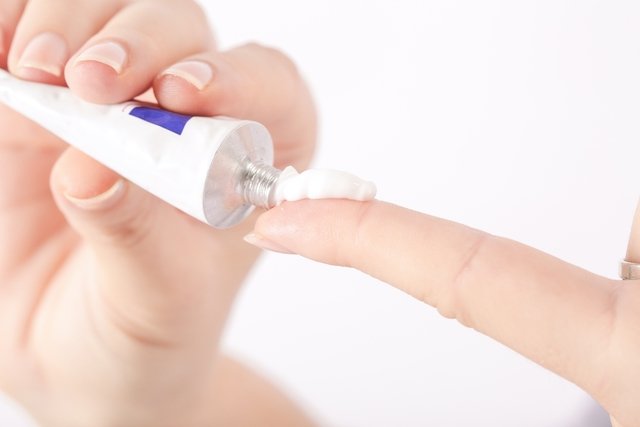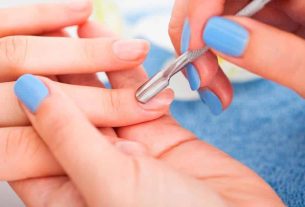Triamcinolone acetonide is a corticosteroid indicated for the treatment of lesions in the mouth mucosa, such as canker sores or mouth ulcers, allergic rhinitis, helping to alleviate symptoms, such as a runny nose or itchy nose, or joint problems.
This remedy can be found in the form of an ointment for oral use, as the generic “triamcinolone acetonide” or under the trade names Omcilon A Orabase, Colujet, Oncicrem-A, Oncileg A or oral Mud, as a nasal spray, under the names Nasacort or Allenasal, or injectable solution, under the name Triancil or Ophtaac.
Furthermore, triamcinolone acetonide can also be found in association with other substances, such as neomycin sulfate, gramicidin and nystatin, indicated for skin inflammations or infections, and should be used under medical advice.

What is it for
Triamcinolone acetonide is typically indicated for:
- Canker sores, ulcers or wounds on the oral mucosasuch as cheeks, gums, inner lips and tongue, caused by trauma;
- Seasonal allergic rhinitiswith symptoms of a runny or blocked nose, intense itching or constant sneezing;
- Inflammation of the uvea of the eye (uveitis), inflammation of the retinal blood vessels or macular edema;
- Joint inflammationssuch as synovitis, bursitis, epicondylitis, rheumatoid arthritis, acute gout arthritis or post-traumatic osteoarthritis.
Furthermore, triamcinolone acetonide, when found in association with other substances, such as neomycin sulfate, gramicidin and nystatin, may be indicated for the topical treatment of dermatoses or skin inflammations or infections.
Triamcinolone acetonide should always be used under medical advice, in the doses and for the duration of treatment advised by the doctor.
How to use
The way to use triamcinolone acetonide varies according to the condition being treated and the presentation of this medicine, and includes:
1. Triancinolone acetonide ointment
Triamcinolone acetonide dermatological ointment or cream for dermatoses is indicated for the treatment or prevention of skin infections, as it contains other substances in its composition, such as neomycin sulfate, gramicidin and nystatin, with anti-inflammatory, antifungal and antibiotic action.
The normally recommended dose for adults is 1 application of the ointment on the affected skin area, 2 to 3 times a day, or as directed by the dermatologist.
2. Injectable triamcinolone
Injectable triamcinolone can be used by applying it directly to the joint or inside the eye, and this application must be carried out by an orthopedist or ophthalmologist.
The dosage of injectable triamcinolone varies according to the condition being treated and the route of administration, which includes:
The duration of treatment with injectable triamcinolone should always be advised by the doctor, as well as the frequency of application.
3. Triancinolone acetonide spray
Triamcinolone acetonide nasal spray for seasonal allergic rhinitis is recommended for adults or children over 4 years of age, with doses varying according to age, which include:
- Adults and children over 12 years old: the normally recommended initial dose is 2 applications of the nasal spray in each nostril, once a day. After symptoms improve, 1 application of the nasal spray is recommended in each nostril, once a day, or as recommended by a doctor;
- Children aged 4 to 12: The normally recommended initial dose is 1 application of the nasal spray in each nostril, once a day, or as directed by your pediatrician.
The bottle of triamcinolone acetonide nasal spray must be shaken before use to mix the formula components and the tip of the applicator must be inserted into the nostril for nasal application. If necessary, you should blow your nose before applying it.
After using triamcinolone acetonide nasal spray, the applicator and protective cap must be cleaned with a tissue or clean cloth. Once a week or if the spray becomes clogged, you must remove the applicator from the bottle and immerse it in warm water for a few minutes. Then rinse in cold water and let it air dry before putting it back in the bottle. Check out other remedies recommended for allergic rhinitis.
4. Triancinolone acetonide orabase
Triamcinolone acetonide orabase is only indicated for adults, and should be used by applying a small amount, directly to the lesion in the mouth, without rubbing, until a thin film forms. To improve the result, the amount used should be just enough to cover the lesion.
The ointment should preferably be applied at night, before going to sleep, so that it exerts its effect throughout the night and, depending on the severity of the symptoms, it can be applied 2 to 3 times a day, preferably after meals.
If after 7 days there is no improvement in symptoms, it is advisable to consult your general practitioner or dentist.
This ointment contains 1mg/g of triamcinolone acetonide, and helps to alleviate the symptoms of cold sore caused by trauma to the oral mucosa, such as pain, discomfort or irritation caused by inflammation in the oral mucosa, in addition to reducing itching and local redness. See other remedies recommended for cold sores.
Possible side effects
The most common side effects of triamcinolone acetonide are a burning sensation, itching, dryness or irritation in the oral, nasal or skin mucosa, headache, pharyngitis, alteration of glucose metabolism, protein degradation, activation of stomach ulcers or production inadequate supply of hormones by the adrenal glands.
Furthermore, in the case of nasal spray, nosebleeds, fever, chills, body pain, blurred vision, eye pain, or seeing halos around lights, for example, may occur.
In the case of dermatological ointment or cream, side effects may arise, such as acne, allergic dermatitis, skin atrophy, formation of stretch marks, skin discoloration at the site of application of the ointment or inflammation in the hair follicle.
In the case of intra-articular injectable triamcinolone, damage to the joint tissues, joint hardening, osteonecrosis, tendon rupture, abscess or bedsores may occur.
When applied inside the eye, triamcinolone can cause glaucoma, drooping of the upper eyelid, infectious or non-infectious inflammation, retinal detachment, ulcer or vitreous hemorrhage.
Who shouldn’t use
Triamcinolone acetonide should not be used by people with a history of allergy to any of the components present in the formula.
Furthermore, this medicine should not be used by pregnant or breastfeeding women, unless recommended by a doctor, after evaluating the benefits of its use for the woman and potential risks for the baby.
In the form of an oral ointment, triamcinolone acetonide should not be used by children or in cases of fungal, viral or bacterial infections of the mouth or throat, such as herpes or tuberculosis. In the form of a nasal spray, this remedy should not be used by children under 4 years of age.
Furthermore, triamcinolone acetonide ointment or dermatological cream associated with other substances should not be used on tuberculosis lesions or skin or systemic viral infections, such as chickenpox, herpes simplex or vaccinia. This ointment should also not be applied to the eyes, or in cases of otitis externa with perforation of the eardrum.
In the case of injection for intraocular application, triamcinolone acetonide is contraindicated for people with systemic infections or allergies to the components of the injection.
Injection into the joint is contraindicated for people with herpetic keratitis, systemic mycoses, active tuberculosis, strongyloidiasis or acute psychosis.

Sign up for our newsletter and stay up to date with exclusive news
that can transform your routine!
Warning: Undefined array key "title" in /home/storelat/public_html/wp-content/plugins/link-whisper-premium/templates/frontend/related-posts.php on line 12
Warning: Undefined array key "title_tag" in /home/storelat/public_html/wp-content/plugins/link-whisper-premium/templates/frontend/related-posts.php on line 13



